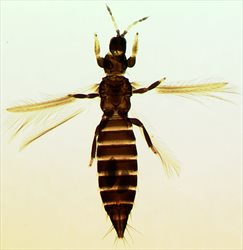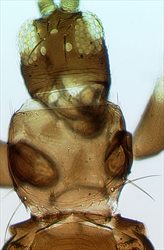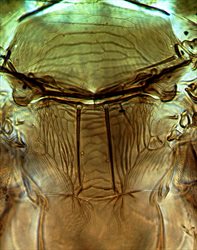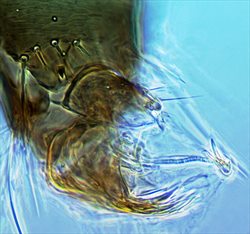
Female

Head & pronotum

Antenna

Fore tibia & tarsus

Meso & metanota

Tergites VII–VIII

Fore wing

Male tergite IX & genitalia

Male tergite IX & genitalia
Both sexes fully winged. Body and legs dark brown, mid and hind tarsi paler, fore tarsi and parts of fore tibiae yellow; antennal segment III yellow, IV light brown; fore wings brown with sub-basal white band. Antennae 8-segmented; segments III–IV constricted to apex, with forked sense cone; segment VI sense cone with enlarged oval base; dorsal apex of segment I with pair of setae. Head wider than long; three pairs of ocellar setae present, pair III as long as distance between compound eyes, arising on or just outside anterior margins of ocellar triangle; maxillary palps 3-segmented. Pronotum with little sculpture, about 10 discal setae and two pairs of long posteroangular setae. Fore tarsus distal segment with 1 or 2 small tubercles; fore tibia apex with prominent re-curved claw ventrally and a seta-bearing tubercle at apex of inner margin. Mesonotum with paired anterior campaniform sensilla, median setae close to posterior margin. Metanotum weakly reticulate; median setae long, arising at anterior margin; campaniform sensilla present medially. Fore wing first vein with setal row almost complete but variable and commonly with small sub-apical gap; setal row complete on second vein. Abdominal tergites with no ctenidia, median setal pair small and wide apart, no sculpture medially; tergite VIII with posteromarginal comb with slender microtrichia laterally but none on median third, with group of microtrichia anterolateral to spiracle; IX with 2 pairs of campaniform sensilla, X with median split. Sternites without discal setae, S1 on VII arising in front of margin.
Male smaller than female; tergite IX with pair of short broad setae posterolaterally; sternites without pore plates; extruded genitalia bearing two stout spines each arising from an elongate trachea-like structure.
The genus Odontothrips currently includes 33 species. All but two of these are from the Holarctic region, including Iran and China, but one species is described from Rajasthan, India, and another from Guinea. From Europe, 19 species of Odontothrips are recorded (zur Strassen, 2003), with eight from Britain. Almost all Odontothrips species breed only in the flowers of Fabaceae (Pitkin, 1972). The fore tibial apex of loti is similar to that of phaleratus, but the fore wing colour and setal row on the first vein are different, and the male genitalia of loti have stout endothecal spines.
Feeding and breeding in flowers and pupating at ground level, and found on various species of Fabaceae in several genera including Lotus, Anthyllis, Ononis and Trifolium.
Common in Britain, and known from Kent to Caithness, though not yet recorded from Wales (Mound et al., 1976). Also recorded from County Wicklow, Republic of Ireland (O'Connor, 2008) and many parts of Europe south from Norway. Present in China (Mirab-balou et al., 2011), and also introduced into North America (Stannard, 1968).
THRIPIDAE - THRIPINAE
Odontothrips loti (Haliday)
Thrips loti Haliday, 1852: 1108
Euthrips ulicis var. californicus Moulton, 1907: 44
Odontothrips ulicis var. adustus Priesner, 1914: 191
Odontothrips uzeli Bagnall, 1919: 262
Odontothrips fasciata Priesner, 1926: 228
Odontothrips anthyllidis Bagnall, 1928: 96
Odontothrips brevipes Bagnall, 1934: 489
Odontothrips quadrimanus Bagnall, 1934: 60
Odontothrips thoracicus Bagnall, 1934: 59
Odontothrips qinlingensis Feng & Zhao, 1994: 1
Odontothrips yinggeensis Feng & Zhang, 2000: 3
Mirab-balou M, Tong X, Feng J & Chen X (2011) Thrips (Thysanoptera) of China. Check List 7: 720–744.
Mound LA, Morison GD, Pitkin BR & Palmer JM (1976) Thysanoptera. Handbooks for the Identification of British Insects 1 (11): 1–79.
O’Connor JP (2008) A review of the Irish thrips (Thysanoptera). Irish Naturalists’ Journal 29: 20–24.
Pitkin BR (1972) A revision of the flower-living genus Odontothrips Amyot & Serville. Bulletin of the British Museum (Natural History) (Entomology) 26: 371–402.
Stannard LJ (1968) The thrips, or Thysanoptera, of Illinois. Bulletin of the Illinois Natural History Survey 29: 213–552.
zur Strassen R (2003) Die terebranten Thysanopteren Europas und des Mittelmeer-Gebietes. Die Tierwelt Deutschlands 74: 1–271.